 Source: Science at Ten (ID: Science_10)
Source: Science at Ten (ID: Science_10) Children love robots, and so do adults. We see them too often in movies, but few know how far robotics has actually developed today. Boston’s robotic dog is certainly captivating, and robots that can spin, jump, and perform flips like humans are enough to amaze anyone. However, just as there is a microscopic world beneath the macroscopic one, microscopic robots are also a field that cannot be underestimated.
Children love robots, and so do adults. We see them too often in movies, but few know how far robotics has actually developed today. Boston’s robotic dog is certainly captivating, and robots that can spin, jump, and perform flips like humans are enough to amaze anyone. However, just as there is a microscopic world beneath the macroscopic one, microscopic robots are also a field that cannot be underestimated.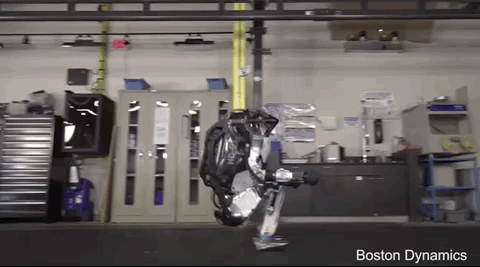 Flipping and jumping robots move very smoothly. | Boston Robotics Imagine one day you buy a smartphone with an app that can control thousands of microscopic robots inside your body, monitoring your health status, or even dancing to music in your blood vessels. That would be amazing! In fact, this scenario seems not far off. — At least, creating these robots and injecting them into your body is something that can be done now (of course, the consequences are not being considered at the moment). Moreover, these robots are surprisingly inexpensive because they can be mass-produced, allowing for the “printing” of several million at once, each costing only a few cents, and they are quite agile!
Flipping and jumping robots move very smoothly. | Boston Robotics Imagine one day you buy a smartphone with an app that can control thousands of microscopic robots inside your body, monitoring your health status, or even dancing to music in your blood vessels. That would be amazing! In fact, this scenario seems not far off. — At least, creating these robots and injecting them into your body is something that can be done now (of course, the consequences are not being considered at the moment). Moreover, these robots are surprisingly inexpensive because they can be mass-produced, allowing for the “printing” of several million at once, each costing only a few cents, and they are quite agile!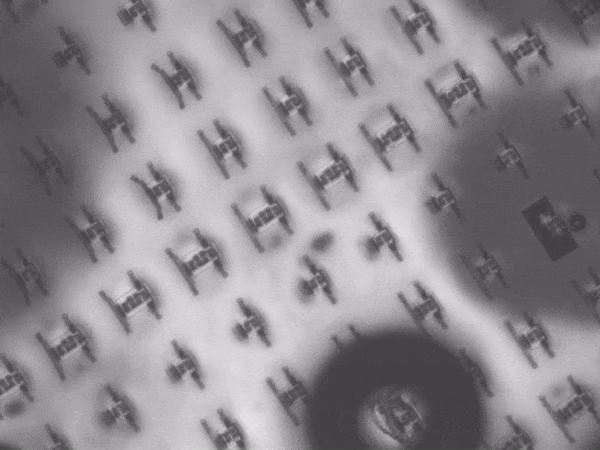 Microscopic walking robots, measuring less than 0.1 millimeters (about the width of a human hair). Researchers even hope to one day place them in the human brain to listen to neurons. Isn’t that a bit mind-blowing? | Cornell UniversityDetails of the research were published in the August issue of Nature.
Microscopic walking robots, measuring less than 0.1 millimeters (about the width of a human hair). Researchers even hope to one day place them in the human brain to listen to neurons. Isn’t that a bit mind-blowing? | Cornell UniversityDetails of the research were published in the August issue of Nature.  Mini Robots Born from New Actuators We may have heard of many types of microscopic robots before, such as DNA origami robots (a type of drug delivery robot assembled from single-stranded DNA that moves through the body’s circulatory system), multi-legged soft robots (made from flexible silicone sheets with hundreds of tiny legs that can move efficiently within the body with the assistance of external electromagnetic devices), and even self-healing living cell robots (composed of skin and cardiac cells that generate asymmetric forces through the contraction of cardiac cells to perform specific movements), etc.
Mini Robots Born from New Actuators We may have heard of many types of microscopic robots before, such as DNA origami robots (a type of drug delivery robot assembled from single-stranded DNA that moves through the body’s circulatory system), multi-legged soft robots (made from flexible silicone sheets with hundreds of tiny legs that can move efficiently within the body with the assistance of external electromagnetic devices), and even self-healing living cell robots (composed of skin and cardiac cells that generate asymmetric forces through the contraction of cardiac cells to perform specific movements), etc. Hexagonal DNA nanotube robots that can open to release drugs (left) and long-legged soft micro robots transporting capsules (right, illustration) | From related papers However, they all seem to come with a hefty price tag or have various shortcomings, such as being inflexible, lacking communication capabilities, having limited functions, being far from practical, and causing immune responses, or being too large… etc. This time, Cornell University scientists have developed a type of microscopic robot that can communicate with the outside and has a wide range of functions using a very simple method. Its size can reach less than 0.1 millimeters, and they can produce millions at once, making the application prospects very promising. The core of this robot’s application lies in its relatively mature “head”; its key breakthrough is its new type of “leg”. From this charming little device, we can see how scientists achieve astonishing technological breakthroughs through a “small” innovation on existing technology. (In fact, its “head” also comes from previous innovations by the same team, which can be said to be “step by step”).
Hexagonal DNA nanotube robots that can open to release drugs (left) and long-legged soft micro robots transporting capsules (right, illustration) | From related papers However, they all seem to come with a hefty price tag or have various shortcomings, such as being inflexible, lacking communication capabilities, having limited functions, being far from practical, and causing immune responses, or being too large… etc. This time, Cornell University scientists have developed a type of microscopic robot that can communicate with the outside and has a wide range of functions using a very simple method. Its size can reach less than 0.1 millimeters, and they can produce millions at once, making the application prospects very promising. The core of this robot’s application lies in its relatively mature “head”; its key breakthrough is its new type of “leg”. From this charming little device, we can see how scientists achieve astonishing technological breakthroughs through a “small” innovation on existing technology. (In fact, its “head” also comes from previous innovations by the same team, which can be said to be “step by step”).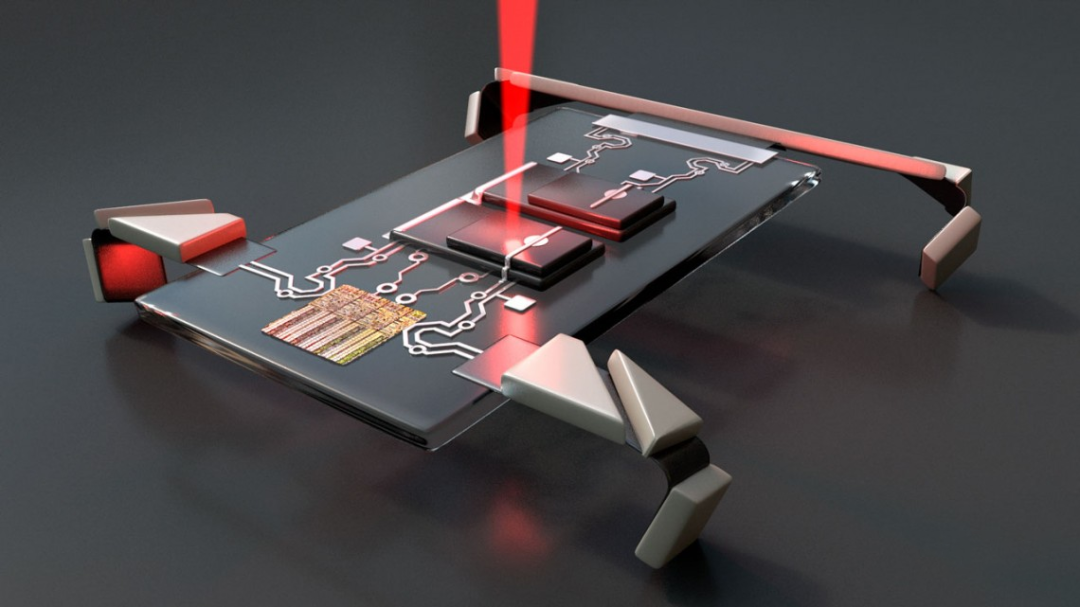 Structure diagram of the micro robot, with a head and legs. | Marc Miskin, et al First, let’s talk about its head, which is, of course, pre-existing. As Picasso once said, good artists copy, great artists steal (good artists copy, great artists steal. — Picasso), the manufacturing process of the robot’s head comes from existing semiconductor manufacturing technology. With over fifty years of development of Moore’s Law, the semiconductor industry is using increasingly advanced production processes to create smaller and smaller devices. Now, these processes can fit millions of transistors into a space roughly the size of a single-celled paramecium. Not only that, but they can also produce micro sensors, LED screens, and a host of packages so small they are invisible. (Moore’s Law states that the number of components that can be accommodated on an integrated circuit doubles approximately every 18 to 24 months at constant prices, and performance also doubles. Proposed by Gordon Moore in 1965, it is nearing its limits.) This is the foundation of mini robots and all current intelligent machines. We can imagine what a robot without legs would look like; indeed, it would resemble the smartphone in your hand. In less than 15 years, it has taken control of the entire world, not only being quite intelligent but also having excellent communication capabilities, all manageable with one hand. The components inside are so numerous that you can only see the circuits on the chip under a microscope. The head of Cornell University’s mini robot is similar, resembling a cell-sized smartphone equipped with dedicated applications, and is over ten thousand times smaller than a normal phone. It is called an Optical Wireless Integrated Circuit (OWIC). It has a small solar cell, and when light is directed onto it, it activates a small circuit that drives a mini LED screen to communicate with the outside world. Just like a firefly.
Structure diagram of the micro robot, with a head and legs. | Marc Miskin, et al First, let’s talk about its head, which is, of course, pre-existing. As Picasso once said, good artists copy, great artists steal (good artists copy, great artists steal. — Picasso), the manufacturing process of the robot’s head comes from existing semiconductor manufacturing technology. With over fifty years of development of Moore’s Law, the semiconductor industry is using increasingly advanced production processes to create smaller and smaller devices. Now, these processes can fit millions of transistors into a space roughly the size of a single-celled paramecium. Not only that, but they can also produce micro sensors, LED screens, and a host of packages so small they are invisible. (Moore’s Law states that the number of components that can be accommodated on an integrated circuit doubles approximately every 18 to 24 months at constant prices, and performance also doubles. Proposed by Gordon Moore in 1965, it is nearing its limits.) This is the foundation of mini robots and all current intelligent machines. We can imagine what a robot without legs would look like; indeed, it would resemble the smartphone in your hand. In less than 15 years, it has taken control of the entire world, not only being quite intelligent but also having excellent communication capabilities, all manageable with one hand. The components inside are so numerous that you can only see the circuits on the chip under a microscope. The head of Cornell University’s mini robot is similar, resembling a cell-sized smartphone equipped with dedicated applications, and is over ten thousand times smaller than a normal phone. It is called an Optical Wireless Integrated Circuit (OWIC). It has a small solar cell, and when light is directed onto it, it activates a small circuit that drives a mini LED screen to communicate with the outside world. Just like a firefly.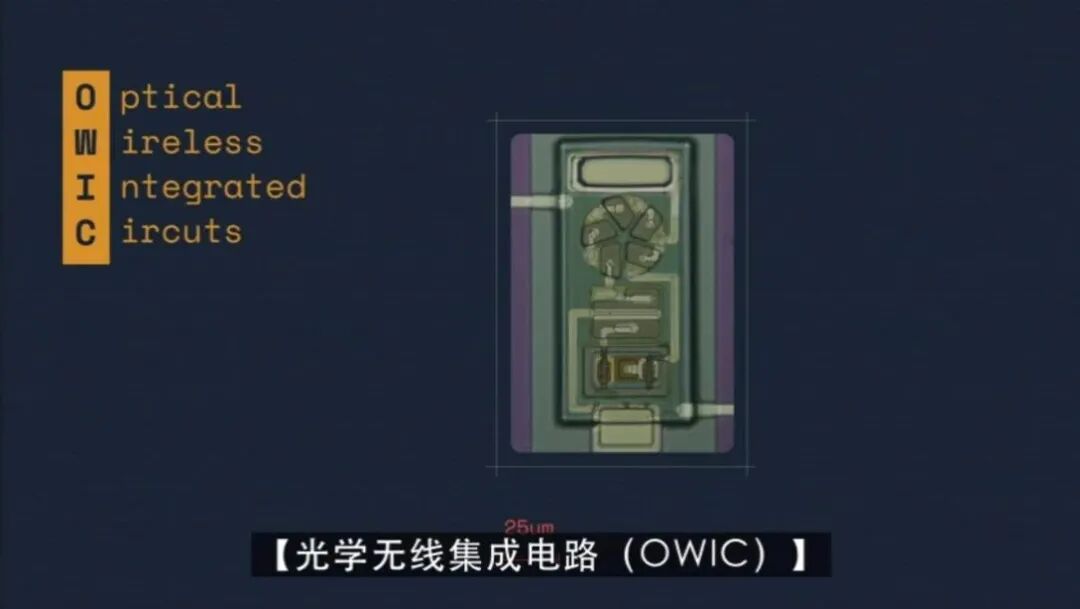 Head of the micro robot, an optical wireless integrated circuit that can be activated by light. | Marc Miskin, et al A cool aspect is that we have different OWICs paired with different sensors (which convert different signals into electrical signals); some can measure voltage, some can measure temperature, or some are just a blinking light to indicate their presence. These OWICs serve as micro-safe smart tags, with recognition capabilities better than fingerprints. They are also used in other medical devices to gather more information and can even be placed in the brain to listen to neurons and transmit signals through LED blinking. However, this is just a “head”; without legs, it cannot move. To become a truly mobile robot, it needs legs. Therefore, based on this, scientists have developed a set of moving legs, or we can call them — actuators. Under a microscope, they can be seen curling under voltage. These legs are so small that they perfectly match the mini head, making red blood cells look like a bread ring next to them. Of course, they are invisible to the naked eye.
Head of the micro robot, an optical wireless integrated circuit that can be activated by light. | Marc Miskin, et al A cool aspect is that we have different OWICs paired with different sensors (which convert different signals into electrical signals); some can measure voltage, some can measure temperature, or some are just a blinking light to indicate their presence. These OWICs serve as micro-safe smart tags, with recognition capabilities better than fingerprints. They are also used in other medical devices to gather more information and can even be placed in the brain to listen to neurons and transmit signals through LED blinking. However, this is just a “head”; without legs, it cannot move. To become a truly mobile robot, it needs legs. Therefore, based on this, scientists have developed a set of moving legs, or we can call them — actuators. Under a microscope, they can be seen curling under voltage. These legs are so small that they perfectly match the mini head, making red blood cells look like a bread ring next to them. Of course, they are invisible to the naked eye.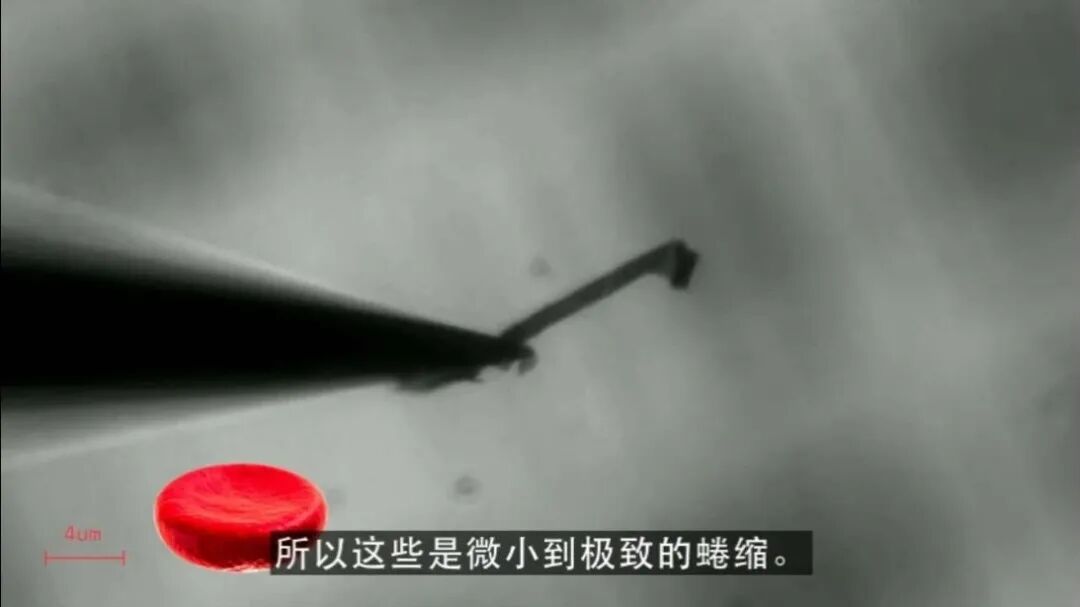 The legs paired with the OWIC, originally straight, curl when voltage is applied. | Marc Miskin, et al
The legs paired with the OWIC, originally straight, curl when voltage is applied. | Marc Miskin, et al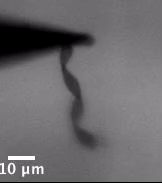 Original strip-shaped legs, stretching and curling animation. | Marc Miskin, et al How does it move? The power comes from a layer of platinum deposited on the legs — about a dozen atomic layers thick. When platinum is placed in water and voltage is applied, atoms in the water will either adsorb or detach from the surface of the platinum — depending on the voltage level — generating force. By controlling the adsorption or repulsion of the atomic layers on the platinum surface, the movement of the legs can be controlled, as one side of the leg is platinum while the other side is titanium or other materials. Since these strip-shaped legs are very thin, they can bend and straighten repeatedly without breaking. Researchers have also created patterns using rigid plates (rigid polymers) that mimic the gaps like human knees and ankles, allowing for predictable bending of the legs to achieve desired movements.
Original strip-shaped legs, stretching and curling animation. | Marc Miskin, et al How does it move? The power comes from a layer of platinum deposited on the legs — about a dozen atomic layers thick. When platinum is placed in water and voltage is applied, atoms in the water will either adsorb or detach from the surface of the platinum — depending on the voltage level — generating force. By controlling the adsorption or repulsion of the atomic layers on the platinum surface, the movement of the legs can be controlled, as one side of the leg is platinum while the other side is titanium or other materials. Since these strip-shaped legs are very thin, they can bend and straighten repeatedly without breaking. Researchers have also created patterns using rigid plates (rigid polymers) that mimic the gaps like human knees and ankles, allowing for predictable bending of the legs to achieve desired movements.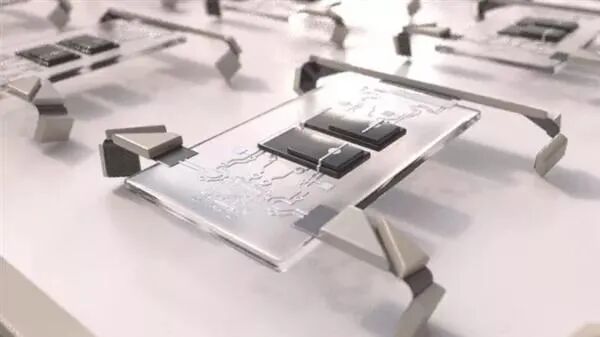 Simulation diagram of the micro robot, note its legs, with small hard pieces on the strips. | Marc Miskin, et al Thus, a mini robot with both a head and legs has emerged. It has both intelligence and driving force. The OWIC serves as its brain, providing us with sensors and power (converting light into voltage) and allowing interaction through light. The platinum layer acts as the muscle, enabling the robot to move around. By projecting a laser onto different solar panels of the OWIC, voltage is generated to select which leg to drive, allowing it to walk.
Simulation diagram of the micro robot, note its legs, with small hard pieces on the strips. | Marc Miskin, et al Thus, a mini robot with both a head and legs has emerged. It has both intelligence and driving force. The OWIC serves as its brain, providing us with sensors and power (converting light into voltage) and allowing interaction through light. The platinum layer acts as the muscle, enabling the robot to move around. By projecting a laser onto different solar panels of the OWIC, voltage is generated to select which leg to drive, allowing it to walk.  Mass Production Using Photolithography However, the brilliance of this research is not just in how small and agile the robot is, but in its ability to be mass-produced, creating millions at once. You might think that the heads and legs need to be manufactured separately and then assembled. In fact, this is not the case; it uses photolithography, just like traditional chip manufacturing, similar to layer-by-layer printing, first “printing” them together on a wafer, and then “etching” them off the bottom substrate with chemicals. The heads and legs can be printed simultaneously, producing millions at once, and when “etched” off, they can freely fold into the shape of finished products.
Mass Production Using Photolithography However, the brilliance of this research is not just in how small and agile the robot is, but in its ability to be mass-produced, creating millions at once. You might think that the heads and legs need to be manufactured separately and then assembled. In fact, this is not the case; it uses photolithography, just like traditional chip manufacturing, similar to layer-by-layer printing, first “printing” them together on a wafer, and then “etching” them off the bottom substrate with chemicals. The heads and legs can be printed simultaneously, producing millions at once, and when “etched” off, they can freely fold into the shape of finished products.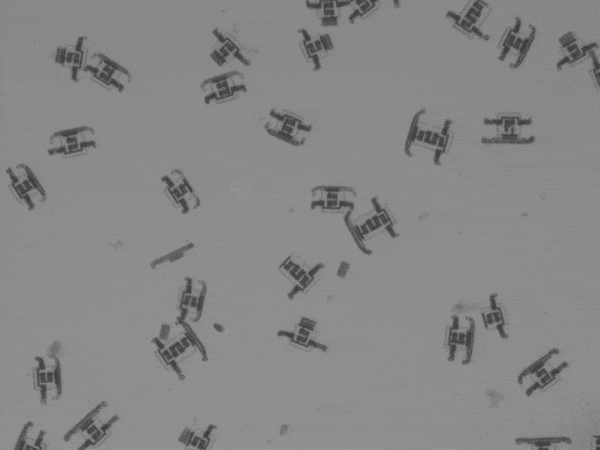 Witness the robots being “etched” off with chemicals, as researchers use a pipette to transfer them elsewhere. | Marc Miskin, et al It is reported that a 4-inch (about 10 cm) round silicon wafer can produce 1 million such robots. They can move with very low voltage and very little energy, making them highly energy-efficient. Additionally, they are very robust, able to withstand various acidic and alkaline environments and temperature changes exceeding 200 degrees Celsius. They can move freely within 20 seconds after manufacturing. Since very weak currents can control their leg movements, they have enormous potential for integration with microelectronic circuits, allowing seamless integration with sensors and logic elements (upgrading the head). This means that in the future, these robots will not only perform simple tasks like walking but can also receive more advanced instructions from sensors and logic circuits, gaining perception and programmability to perform rich and complex activities. One day, they might even become our resident engineers inside our bodies, injected through a tiny needle, allowing thousands of robots to perform various functions. Just like now, they can already pass through needles without any damage.
Witness the robots being “etched” off with chemicals, as researchers use a pipette to transfer them elsewhere. | Marc Miskin, et al It is reported that a 4-inch (about 10 cm) round silicon wafer can produce 1 million such robots. They can move with very low voltage and very little energy, making them highly energy-efficient. Additionally, they are very robust, able to withstand various acidic and alkaline environments and temperature changes exceeding 200 degrees Celsius. They can move freely within 20 seconds after manufacturing. Since very weak currents can control their leg movements, they have enormous potential for integration with microelectronic circuits, allowing seamless integration with sensors and logic elements (upgrading the head). This means that in the future, these robots will not only perform simple tasks like walking but can also receive more advanced instructions from sensors and logic circuits, gaining perception and programmability to perform rich and complex activities. One day, they might even become our resident engineers inside our bodies, injected through a tiny needle, allowing thousands of robots to perform various functions. Just like now, they can already pass through needles without any damage.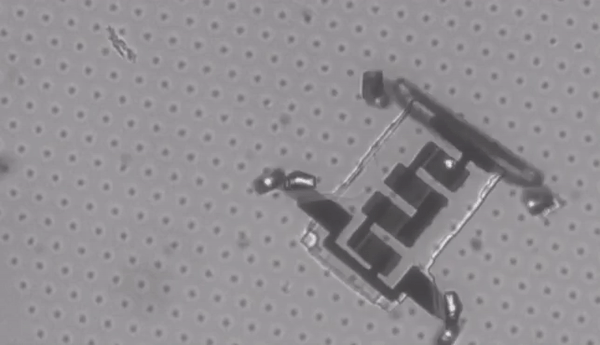 Microscopic robots so small that they can be injected into the body through a needle without any damage. | Marc Miskin, et al
Microscopic robots so small that they can be injected into the body through a needle without any damage. | Marc Miskin, et al Inevitable Bottlenecks and Extraordinary Application Prospects However, there are always some limitations. This robot currently faces some bottlenecks. For instance, at present, they have not yet escaped direct human control. In other words, they are still a group of puppets. Their energy source, computing, and decision-making components are separate from the body, and researchers still need to use lasers to provide instructions to the robots. This is essentially still a size limitation. If fully autonomous robots can be created by integrating energy storage, logic circuits, and sensors, the application prospects would certainly be broader. However, at small scales, there are stricter technical limitations; functions that can be achieved on 500-micron-sized micro robots may be exceptionally difficult on 50-micron robots, and perhaps impossible on 5-micron robots. Therefore, this robot currently serves more as a model, showcasing the extraordinary application prospects of microscopic robots before we break through technical limitations. If one day we overcome all these bottlenecks, we will truly welcome an artificial microscopic world. In that world, countless robots will live in our tissues and blood like bacteria, alerting us to potential health risks and performing surgical procedures when necessary; when cells become cancerous, they will gather to bravely fight against cancer cells and inform us of our condition through our smartphones. When our children go out to collect a drop of water and place it under a microscope, they will see not only paramecia and bacteria but also tiny robots, witnessing our strange interaction with nature. I really look forward to that day; I wonder if you feel the same way.Original paper:Electronically integrated, mass-manufactured, microscopic robots. Nature 584, 557–561(2020)Reference information:https://www.nature.com/articles/s41586-020-2626-9https://www.nature.com/articles/d41586-020-02421-2https://www.nature.com/articles/d41586-020-02486-zhttps://www.ted.com/talks/paul_mceuen_and_marc_miskin_tiny_robots_with_giant_potential#t-774764
Inevitable Bottlenecks and Extraordinary Application Prospects However, there are always some limitations. This robot currently faces some bottlenecks. For instance, at present, they have not yet escaped direct human control. In other words, they are still a group of puppets. Their energy source, computing, and decision-making components are separate from the body, and researchers still need to use lasers to provide instructions to the robots. This is essentially still a size limitation. If fully autonomous robots can be created by integrating energy storage, logic circuits, and sensors, the application prospects would certainly be broader. However, at small scales, there are stricter technical limitations; functions that can be achieved on 500-micron-sized micro robots may be exceptionally difficult on 50-micron robots, and perhaps impossible on 5-micron robots. Therefore, this robot currently serves more as a model, showcasing the extraordinary application prospects of microscopic robots before we break through technical limitations. If one day we overcome all these bottlenecks, we will truly welcome an artificial microscopic world. In that world, countless robots will live in our tissues and blood like bacteria, alerting us to potential health risks and performing surgical procedures when necessary; when cells become cancerous, they will gather to bravely fight against cancer cells and inform us of our condition through our smartphones. When our children go out to collect a drop of water and place it under a microscope, they will see not only paramecia and bacteria but also tiny robots, witnessing our strange interaction with nature. I really look forward to that day; I wonder if you feel the same way.Original paper:Electronically integrated, mass-manufactured, microscopic robots. Nature 584, 557–561(2020)Reference information:https://www.nature.com/articles/s41586-020-2626-9https://www.nature.com/articles/d41586-020-02421-2https://www.nature.com/articles/d41586-020-02486-zhttps://www.ted.com/talks/paul_mceuen_and_marc_miskin_tiny_robots_with_giant_potential#t-774764

 Recently, the WeChat public account’s push mechanism has changed again, and everyone canlight up “Looking” more, or set the toxic tongue as “Star Mark” to prevent losing contact!
Recently, the WeChat public account’s push mechanism has changed again, and everyone canlight up “Looking” more, or set the toxic tongue as “Star Mark” to prevent losing contact!

